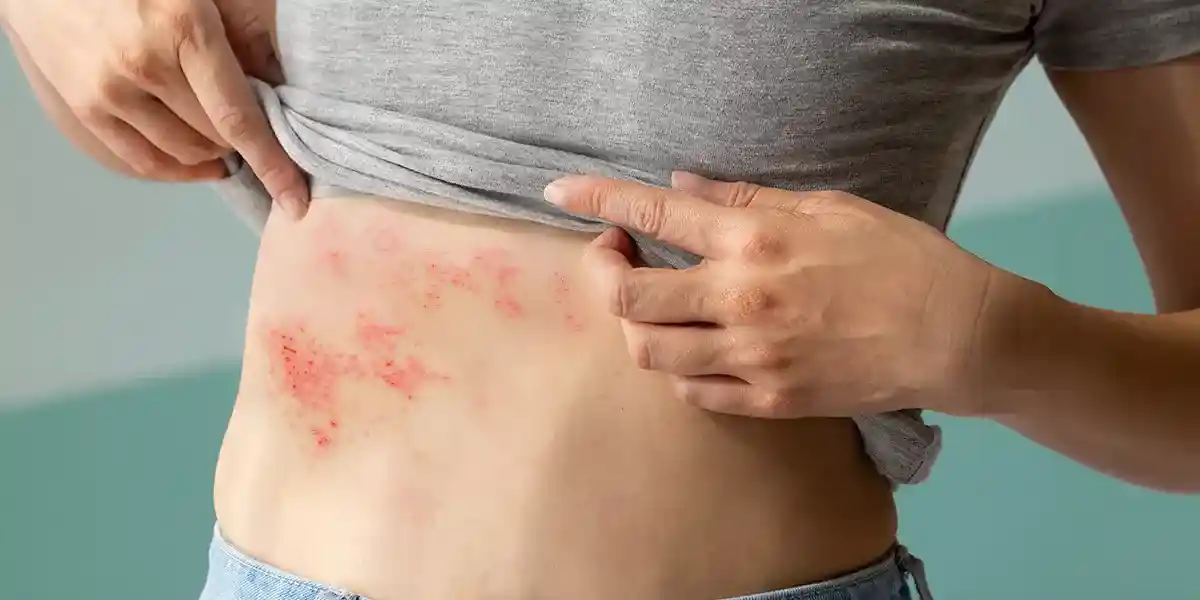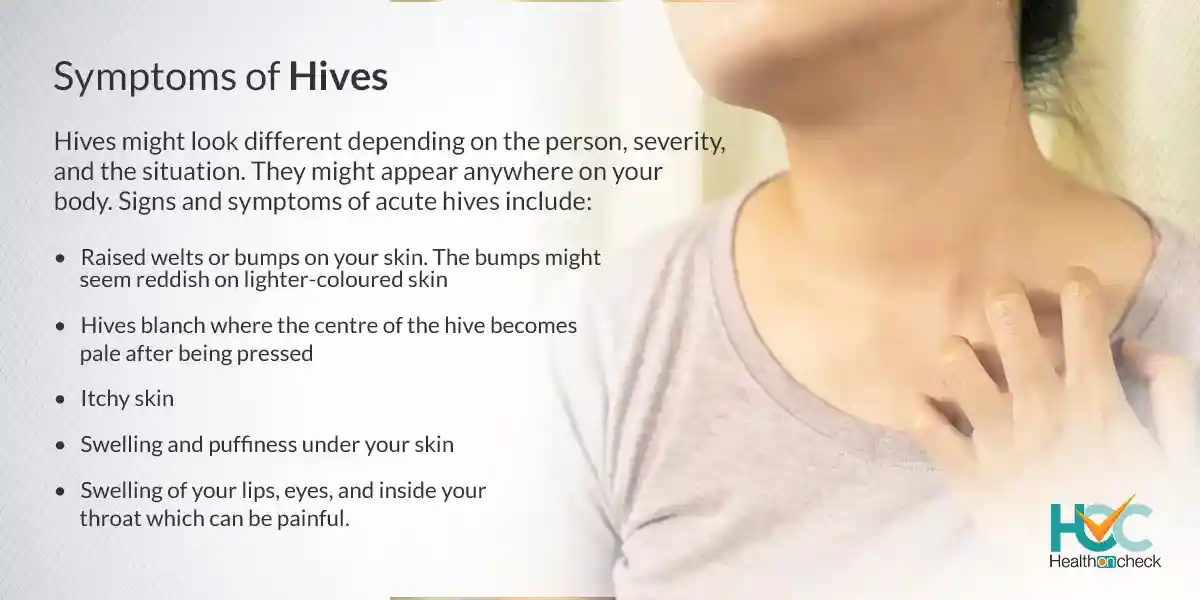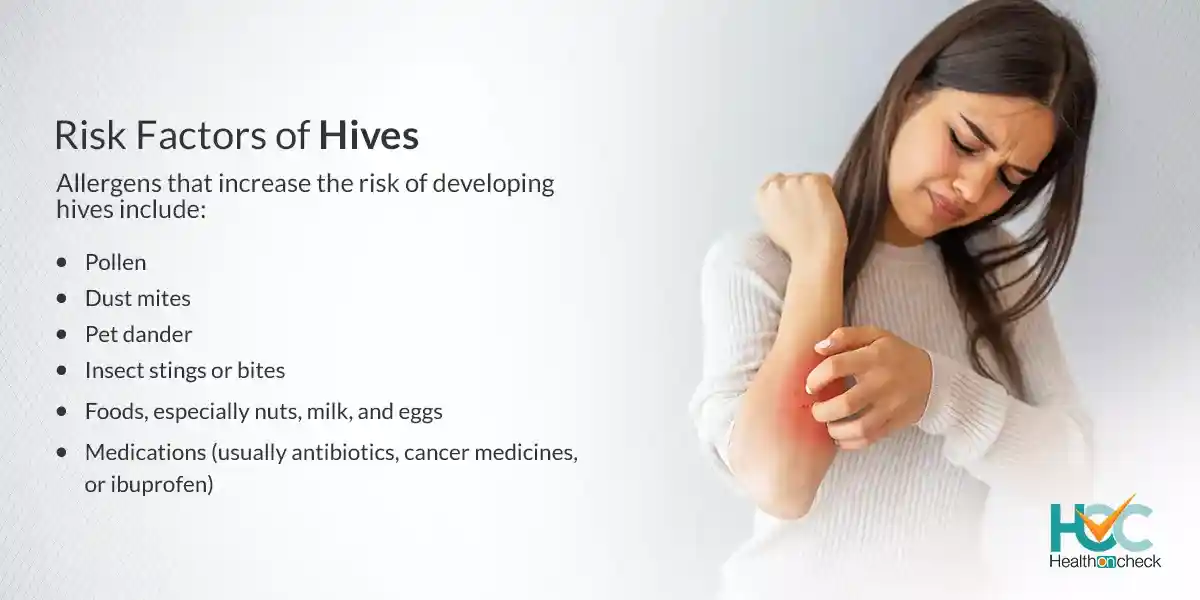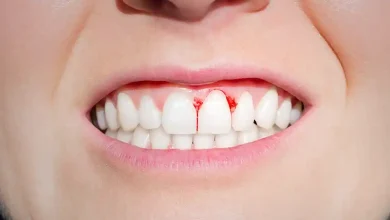All About Hives

What are Hives?
Hives are itchy, raised welts that form on the skin. Usually, they are pink, red, or flesh-coloured on lighter skin and might be flesh-coloured or a little bit lighter or darker than your skin tone on black or brown skin. Hives usually occur because of an allergic response to something in your environment or something you ate to which you are allergic but a few times they might also develop due to an underlying health condition. Hives are generally quite itchy, and sometimes there might be feelings of burning or stinging. Hives can be as tiny as a fingertip or as huge as a dinner plate. The medical term for hives is urticaria. Generally, hives fade within 24 hours, however, they might be noticeable for many days or longer.
What are the Types of Hives?
The types of hives include:
Acute urticaria: These are the types of hives not lasting very long (less than six weeks).
Chronic urticaria: These are the types of hives that occur at least twice a week for above six weeks.
Chronic, spontaneous urticaria: It’s the term for chronic hives not having an obvious cause. It was earlier known as chronic idiopathic urticaria.
Physical urticaria, or inducible urticaria: These types of hives may form when you’re in the heat, cold, or sun and they typically appear within an hour after exposure. This type of hive can also be chronic.
What are the Symptoms of Hives?
Hives might look different depending on the person, severity, and the situation. They might appear anywhere on your body. Signs and symptoms of acute hives include:

- Raised welts or bumps on your skin. The bumps might seem reddish on lighter-coloured skin.
- Hives blanch where the centre of the hive becomes pale after being pressed.
- Itchy skin.
- Swelling and puffiness under your skin.
- Swelling of your lips, eyes, and inside your throat which can be painful.
In various aspects, chronic hives and acute hives might seem similar and they could be itchy, swollen raised welts turning lighter in the centre and with pressure.
However, chronic hives could be:
- Change sizes and shapes.
- Appear, disappear, and then return at least every few days for a long time, even months or years.
- Might occur because of heat, exercise, or stress.
What are the Causes of Hives?
Hives generally form because of an allergic reaction to something that you have touched or consumed. When you have an allergic reaction, your body starts to produce histamines in your blood. Histamines are chemicals your body releases to protect itself against infection and other alien elements.
In some people, histamines might lead to itching, swelling, and the symptoms associated with hives. Allergens such as pollen, certain foods, medications, animal dander, and insect bites can cause hives.
Some circumstances besides allergies can also cause hives and it’s common for some people to have hives because of stress, tight clothes, exercise, illnesses, or infections.
Hives might also appear due to excessive exposure to hot or cold temperatures or irritation because of excessive sweating. Because there are various potential factors, many times the real cause of hives can’t be detected.
What are the Risk Factors of Hives?
People prone to allergies are at increased risk of getting hives. If you’re taking medication or if you’re unknowingly exposed to things you might be allergic to, like food or pollen, then also you are likely to get hives. If you’re already having an infection or a health condition, then your risk of developing hives increases.

Allergens that increase the risk of developing hives include:
- Foods, especially nuts, milk, and eggs
- Pet dander
- Pollen
- Dust mites
- Insect stings or bites
- Medications (usually antibiotics, cancer medicines, or ibuprofen)
What are the Complications of Hives?
The complications of hives might include:
Anaphylaxis: A severe and fatal, whole-body allergic reaction that leads to breathing problems.
- Also swelling in the throat can cause life-threatening blockage in the airway.
How Hives are Diagnosed?
Hives can be simply diagnosed by looking at your skin. Your doctor might prescribe allergy tests to determine what’s causing a reaction and identifying the cause can be helpful for you to avoid allergens and the hives that develop with them. Allergy tests to diagnose hives include:
Skin tests: In this procedure, your doctor will test various allergens on your skin and if your skin becomes red or swells, it means you’re allergic to that element. This type of allergy test is also known as a skin prick or scratch test.
Blood tests: A blood test helps to determine particular antibodies in your blood. Your body creates antibodies to combat allergens and in case your body creates lots of antibodies, you might get hives and swelling.
What are the Treatment Options Available for Hives?
Hives usually go away on their own without treatment and sometimes your doctor may prescribe medications and at-home care to help you feel better and lessen your chances of getting hives again.
The treatment options for hives usually include:
Allergy medications: Your doctor might prescribe drugs called antihistamines which block the effects of histamine. These medicines are consumed orally in the form of pills or can be applied to affected skin. They provide relief from itching and remove allergic reactions or make them less severe. Some antihistamines including diphenhydramine start reacting quickly. Your doctor will prescribe daily allergy medications based on how severe the hives are.
Allergy shots: Your doctor might refer to monthly injections of drugs to block allergic reactions for difficult-to-treat chronic hives. People with serious allergies start producing lots of IgE and these allergy shots help to block your immune system from creating IgE.
At-home treatments: To ease the symptoms of hives, taking a cool bath or shower, wearing loose-fitting clothing, and applying cold compresses can be helpful. An over-the-counter (OTC) hydrocortisone or antihistamine cream can also help to lessen swelling and itching.
Oral steroids: Corticosteroids, like prednisone, are helpful to ease the symptoms of hives that are not responding to antihistamines or topical steroids.
Epinephrine: Severe acute allergic reactions can cause a life-threatening condition known as anaphylaxis whose symptoms include hives, swelling of your face, mouth, or throat, shortness of breath, wheezing, vomiting, and low blood pressure. People suffering from this condition require an immediate epinephrine injection to open a swollen airway.
Living with Hives
Hives are your body’s way of responding to a sensitive substance (allergen) which can be uncomfortable, but usually, they are not serious. You might develop hives alone, or they may come with swelling, or sometimes there might be just swelling. Most of the time, these reactions fade away in one or two days. If you are more likely to have these reactions, you should discuss with your doctor about getting tested for causes. After determining the triggers of your allergies, you might take the necessary steps to avoid your triggers and treat reactions.
Whom to Consult?
You should contact your doctor if you have severe hives or hives that last for more than a few days. But unlike acute hives, chronic hives do not go away in a few days and might take much longer. You should let your doctor know if treatment isn’t effective. If you get hives as part of a serious allergic reaction known as anaphylaxis, you should go for immediate medical assistance as it can sometimes be life-threatening.




